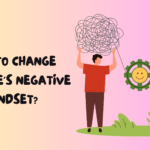How to Correct Negative Thinking: Negative thinking is something everyone experiences at some point. It can be a result of stress, past experiences, low self-esteem, or fear of failure. However, when negative thoughts become a habit, they can affect mental health, lower self-confidence, and make life feel more difficult than it actually is.
The good news is that negative thinking is not permanent. With conscious effort, you can train your mind to think more positively, realistically, and productively. This article will explore why negative thinking happens and provide actionable steps to correct it so that you can develop a healthier mindset.
Also Read:
- What to do When Nothing Makes You Happy?
- How to Get Rid of Chronic Stress?
- How to be Calm and Confident under Pressure?
How to Correct Negative Thinking?
1. Understanding Negative Thinking
Before you can correct negative thoughts, it’s important to recognize them.
A. Common Types of Negative Thinking
- All-or-Nothing Thinking – Seeing things as either perfect or a complete failure. Example: “If I don’t succeed, I’m a total failure.”
- Overgeneralization – Believing that one bad experience means everything will always go wrong. Example: “I failed this test, so I’ll fail every test.”
- Mind Reading – Assuming you know what others think, usually in a negative way. Example: “They didn’t reply, so they must not like me.”
- Catastrophizing – Expecting the worst-case scenario in every situation. Example: “If I lose my job, my whole life will be ruined.”
- Personalization – Blaming yourself for things that aren’t entirely your fault. Example: “My friend is upset; it must be because of something I did.”
- Filtering – Focusing only on the negatives and ignoring the positives. Example: “I got one bad comment on my work, so I must not be good enough.”
B. Why Negative Thinking Happens
- Past experiences and trauma shape how we see the world.
- Fear and anxiety make us focus on worst-case scenarios.
- Low self-esteem makes us believe negative thoughts about ourselves.
- Social influences (news, social media, and negative people) impact our mindset.
Now that we understand the causes and types of negative thinking, let’s explore ways to correct it.
2. How to Correct Negative Thinking
A. Identify Your Negative Thoughts
The first step to correcting negative thinking is awareness.
- Pay attention to your thoughts throughout the day.
- Write down recurring negative thoughts in a journal.
- Identify patterns—do you tend to think negatively about yourself, your future, or others?
Once you recognize your negative thought patterns, it becomes easier to challenge and replace them.
B. Challenge Negative Thoughts
Ask yourself:
✔️ Is this thought true?
✔️ Is there real evidence to support it?
✔️ Am I jumping to conclusions or assuming the worst?
✔️ What would I tell a friend who had this thought?
For example:
❌ “I will never succeed.”
✅ “I have struggled before, but I have also succeeded in many things. This is just a challenge, not a permanent failure.”
By questioning your thoughts, you weaken their power over you.
C. Reframe Negative Thoughts into Positive Ones
Once you challenge a negative thought, replace it with a more positive and realistic one.
- ❌ “I always make mistakes.” → ✅ “Mistakes help me learn and improve.”
- ❌ “Nobody likes me.” → ✅ “I have people who care about me, and I can always make new connections.”
- ❌ “I’m not good enough.” → ✅ “I am capable, and I can keep improving.”
This shift trains your brain to see possibilities instead of limitations.
D. Practice Gratitude
Gratitude helps shift focus from negative thoughts to positive aspects of life.
- Start a gratitude journal—write down three things you’re grateful for daily.
- Focus on small, everyday positives, like a kind conversation or a beautiful sunset.
- When negative thoughts arise, remind yourself of good things in your life.
Over time, gratitude rewires your brain to naturally focus on positivity.
E. Surround Yourself with Positivity
Your environment affects your mindset. To reduce negativity:
✔️ Avoid toxic people who drain your energy.
✔️ Follow positive and inspiring content on social media.
✔️ Spend time with supportive friends and family.
✔️ Listen to uplifting music, books, and podcasts.
Being around positivity makes it easier to think positively.
F. Take Care of Your Body
Physical health and mental health are deeply connected.
- Exercise regularly—physical activity releases endorphins, which naturally boost mood.
- Eat nutritious food—a balanced diet helps maintain mental clarity.
- Get enough sleep—lack of rest increases stress and negative thinking.
- Practice mindfulness and meditation—this helps break the cycle of overthinking.
A healthy body supports a healthy and positive mind.
G. Focus on Solutions Instead of Problems
Instead of dwelling on problems, shift your mindset toward solutions.
- Ask: “What can I do to improve this situation?”
- Break big problems into small, manageable steps.
- Take positive actions, even if they’re small.
For example:
❌ “I’m stuck in a job I hate.”
✅ “I can start learning new skills or networking to find better opportunities.”
Focusing on solutions empowers you instead of making you feel helpless.
H. Use Positive Affirmations
Affirmations are positive statements that help reprogram your thoughts.
- Say them daily in front of a mirror or write them in a journal.
- Examples:
✅ “I am strong and capable.”
✅ “I choose to see the good in every situation.”
✅ “I deserve happiness and success.”
Repeatedly affirming positive beliefs helps them become part of your mindset.
I. Accept That Setbacks Are Normal
No one can completely eliminate negative thoughts, but you can learn to manage them better.
- Accept that occasional negative thinking is normal.
- Instead of feeling guilty, remind yourself that progress takes time.
- Treat your mind like a muscle—the more you practice positivity, the stronger it becomes.
3. Building Long-Term Positive Thinking
To make these changes permanent, incorporate them into your daily life:
✔️ Daily reflection – Take 5 minutes to check in with your thoughts.
✔️ Consistent gratitude – Make gratitude a daily habit.
✔️ Healthy routines – Exercise, eat well, and sleep enough.
✔️ Mindfulness – Practice deep breathing and staying present.
✔️ Personal growth – Read books, listen to inspiring content, and keep learning.
Over time, these habits rewire your brain to think positively by default.
Conclusion
Correcting negative thinking is not about ignoring problems or forcing fake positivity. Instead, it’s about changing how you interpret challenges and setbacks.
By identifying negative thoughts, challenging them, reframing them into positive ones, practicing gratitude, and making positive changes in your daily life, you can develop a mindset that helps you handle life’s challenges with strength and optimism.








